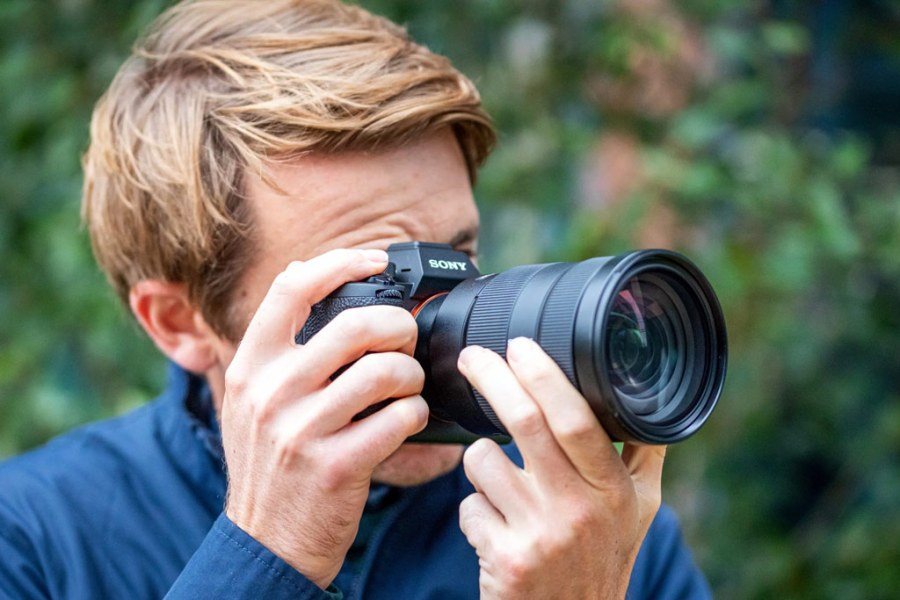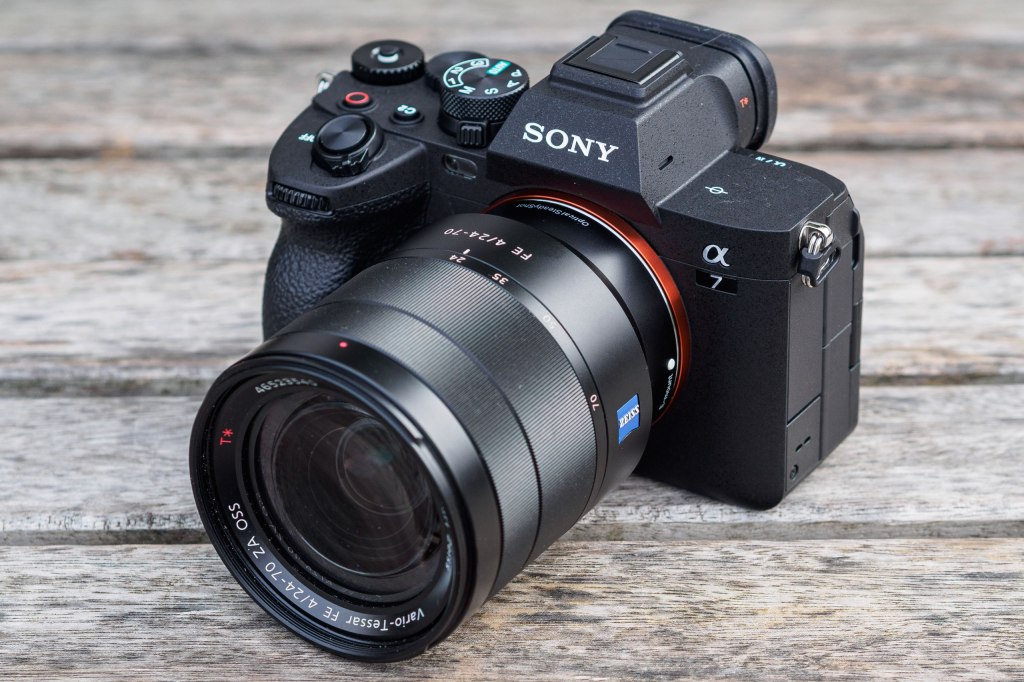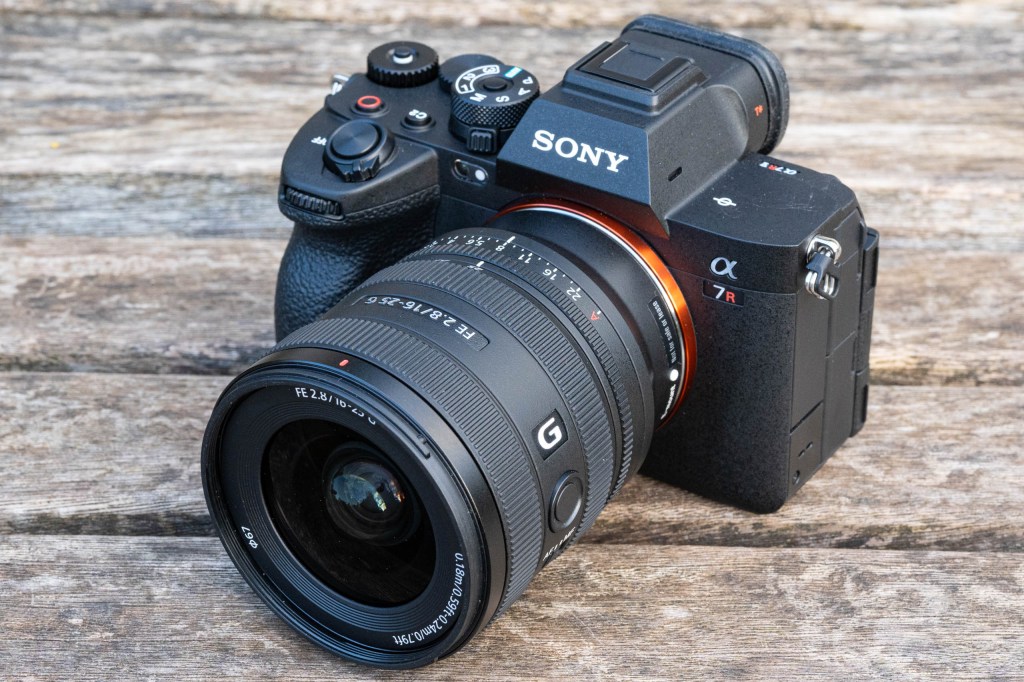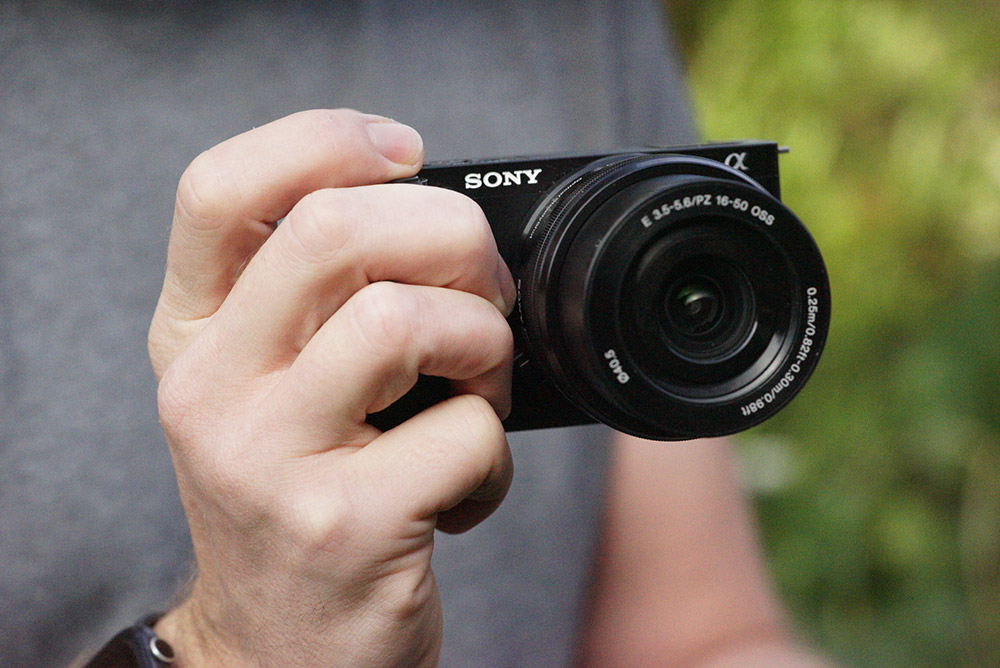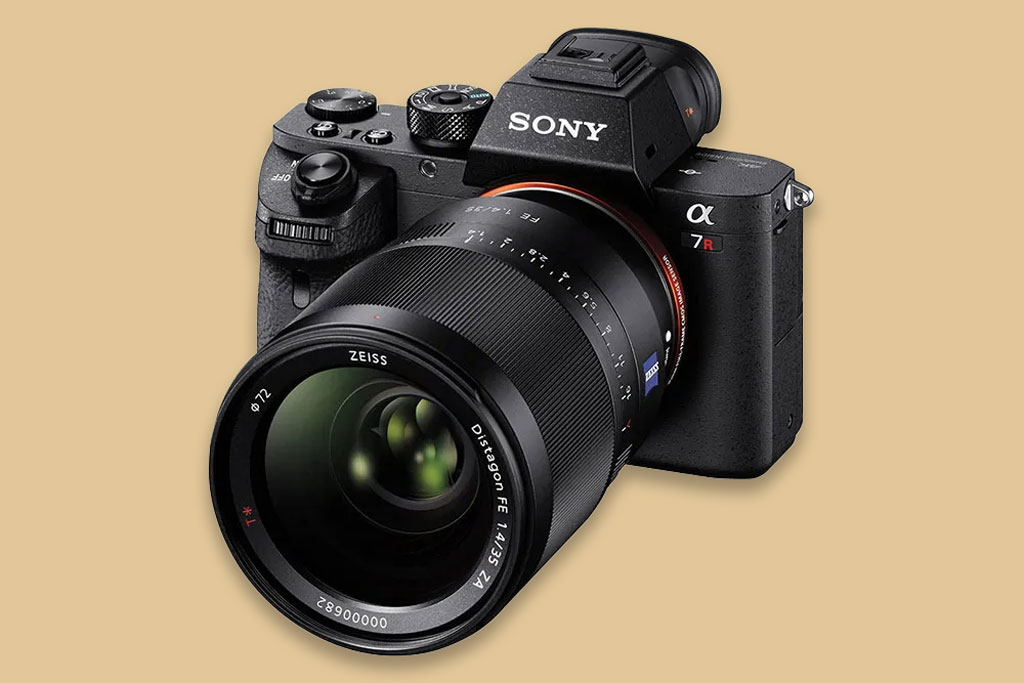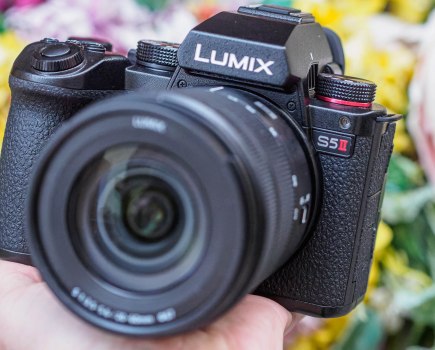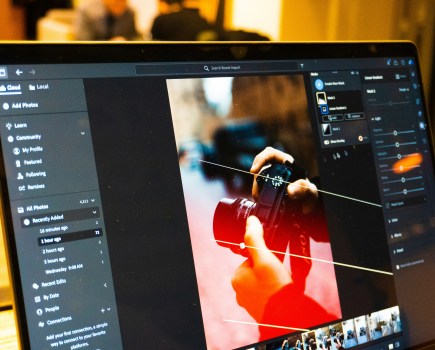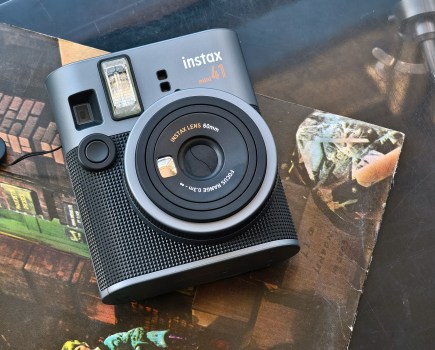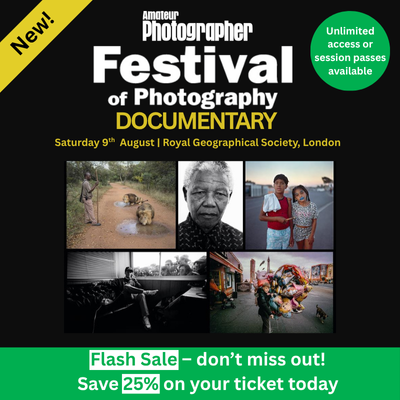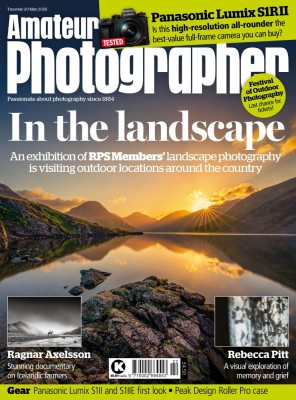With the best Sony cameras, there really is something for everyone. The manufacturer has built up one of the broadest mirrorless ranges in the business, with full-frame and APS-C cameras for professionals, amateurs, vloggers and everyone in between. And for those who prefer an all-in-one camera, there are also the excellent Sony Cyber-shot compacts.
We test and review every new Sony camera that is released. In these guides, we only recommend cameras that our team has hands-on experience with, so you can be sure you’re getting something that justifies its asking price. We’ve picked out a broad range of cameras here, so whether you’re into wildlife photography, or landscape photography, or just shooting photos for social media, there will be a great Sony camera here for you.
We’ve also included an explainer section at the bottom of this page for anyone who is new to Sony gear. You can click through to our full reviews of each camera in every entry – and remember to also have a look at the best Sony lenses to pair with your camera.
Best Sony cameras: our quick list
Looking for the best deal on Sony cameras? Not only will you find the best Sony cameras, but you’ll also find some of the best Sony camera deals, as our ‘Buy now’ buttons are setup to automatically take you to the best prices, from trusted retailers, plus you’ll also find a list of other retailers below each camera, so you can find the right deal for you.
Want to cut to the chase? Here’s our quick list of the best Sony cameras to buy, along with links to get the best prices…
- Best Sony camera for photography: Sony A7 IV – Buy now
- Best Sony camera for resolution: Sony A7R V – Buy now
- Best budget Sony camera: Sony ZV-E10 – Buy now
- Best lightweight full-frame Sony camera: Sony A7C II – Buy now
- Best APS-C Sony camera all round: Sony A6700 – Buy now
- Best lightweight high-res Sony camera: Sony A7CR – Buy now
- Best professional Sony camera: Sony A1 II – Buy now
- Best Sony camera for sports photography: Sony A9 III – Buy now
- Best Sony camera for video: Sony A7S III – Buy now
- Best Sony compact for travel photography: Sony RX100 VII– Buy now
- Best Sony for travel vlogging: Sony ZV-1 Mark II – Buy now
- Best Sony bridge camera: Sony Cyber-Shot RX10 IV – Buy now
Read on to learn more about each of these excellent cameras…
Why you can trust Amateur Photographer
We spend many hours testing every product we recommend, in detail, in a variety of situations and shooting scenarios, and only use experts for our reviews, so you can be sure that you’re getting the best products. Find out more about our expert writers.
Best for photography
Best Sony camera for photography all round: Sony A7 IV
Amateur Photographer verdict
For any serious enthusiast contemplating buying a new camera, it has to be right at the top of the list.- Excellent image quality
- Intelligent, flexible autofocus
- Articulated screen
- AF system complex to configure
- No in-camera raw conversion
Specifications at a glance:
| Camera type | Mirrorless |
| Sensor | 33MP full-frame Exmor-R CMOS |
| Continuous shooting | 10 frames per second |
| ISO | ISO 50-204,800 (extended) |
| Video | 4K 30p |
The Sony A7 cameras have always been good for a bit of everything. While the A7R models focus on resolution, the A7S models on low-light video and the A9 models (and A1) on speed, the A7 cameras have quietly gone about the business of being some of the best full-frame all-rounders on the market.
The Sony A7 IV is great, kicking it up a gear in response to increased competition from Canon and Nikon. This translates to a revamped 33MP sensor, with 10fps burst shooting and super-fast autofocus to play with, as well as handling improvements like a fully articulating LCD screen and a higher-resolution viewfinder.
The impressive range of full-frame E-mount lenses allows you to customise the system according to what you plan to shoot. For serious photographers, it’s one of the most fully-featured cameras you can buy right now without getting into ultra-pro territory.
With the A7 IV, Sony has produced a substantially improved camera that offers enough updates not only to tempt its existing users to upgrade, but also to turn the heads of DSLR users who might be considering making the transition to mirrorless.’
Best for: enthusiast photographers who want to shoot all kinds of subjects
Read our Sony A7 IV Review.
Best for resolution
Best Sony camera for resolution: Sony A7R V
Amateur Photographer verdict
Overall, if your needs are tilted more towards image quality than outright speed, it’s difficult to argue against the Sony Alpha 7R V being the best full-frame stills camera available.- 8K video
- AI-enhanced autofocus
- Big buffer capacity
- Huge resolution
- Very expensive
- And you probably don’t need everything its offering
Specifications at a glance:
| Camera type | Mirrorless |
| Sensor | 61MP full-frame Exmor R CMOS |
| Continuous shooting | 10 frames per second |
| ISO | ISO 50-102,400 (extended) |
| Video | 8K 24p |
The Sony A7R V is the latest in the high-resolution line of A7R cameras. However, given that the A7R V boasts class-leading AI autofocus, increased buffer capacity and 8K video capability, the lines between different Sony cameras are becoming more and more blurred.
Whereas different Sony cameras used to be specialists in different areas, we’re seeing more cameras like the A7R V and A1 that are simply good at everything – and are priced accordingly. Is this a good strategy? We’ll find out in the years to come, but in the meantime, the result is undeniably great cameras like the A7R V.
61MP full frame sensor
So, what we get here is the same 61MP sensor as the Sony A7R IV. While some might be disappointed that it’s not an upgrade, that many pixels are difficult to argue with. If you want higher resolution than that, you’re probably looking at medium format anyway.
Elsewhere on the camera is an upgraded autofocus system, with enhanced subject detection powered by a new AI processing unit. It’s capable of recognising a huge range of subjects, including cars, trains, airplanes, insects, and the usual human, animal, and bird. According to Sony, this unit also improves metering and auto white balance.
Low-res shooting options
Stabilisation has been dramatically improved, now delivering up to 8 stops of effective exposure compensation with the right lens. Users also have more image recording options to help manage those huge 61MP files, including lossless raw compression, and lower resolution options (26MP and 15MP) for those times you don’t need all that detail.
It all adds up to a hell of a camera. Is it worth almost $4,000/£4,000? That’s up to the individual user. Our conclusion in our review was as follows: ‘If your needs are tilted more towards image quality than outright speed, it’s difficult to argue against the Sony Alpha 7R V being the best full-frame stills camera available… if you can justify the A7R V’s price, you’ll be blown away by just how good it is.‘
Best for: making large prints
Read our Sony A7R V review.
Best budget option
Best budget Sony camera: Sony ZV-E10
Amateur Photographer verdict
Beneath its lightweight exterior it packs quite a punch, it shows its full potential when paired with something better then its rather average kit lens.- Fully articulating 3-inch touchscreen
- Lightweight build
- Good high-ISO performance
- No viewfinder
- No mode dial
Specifications at a glance:
| Camera type | Mirrorless |
| Sensor | 24.2MP APS-C CMOS |
| Continuous shooting | 11 frames per second |
| ISO | ISO 64-51,200 (extended) |
| Video | 4K 30p |
Sony’s ZV series cameras are expressly designed for vlogging, delivering a highly portable video setup. The Sony ZV-E10 is the first mirrorless camera in the series; like the A6000, it sports a 24MP APS-C sensor. It takes a lot of design cues from the first camera in the series, the Sony ZV-1 compact, but having the option to swap out E-mount lenses gives you a great deal more flexibility.
Ideal for run-and-gun vloggers
The ZV-E10 packs in a lot of vlogger-specific features. Its built-in 3-way capsule microphone gives it on-board audio recording performance that is head and shoulders above most consumer cameras. You can also attach an external mic if you prefer. While its video capabilities won’t match those of flagship cameras like the Sony A7S III, the ZV-E10 works brilliantly as an agile setup for run-and-gun vloggers.
You can also think of it as a vlogging-focused evolution of Sony’s A6000-series cameras, and while it doesn’t have a viewfinder, its vari-angle screen and lower price make it a very compelling alternative.
As we said in our review, ‘For content creators there are few creative things that the ZV-E10 won’t allow you to do.’
The second generation, improved Sony ZV-E10 II just hit the shelves packing some of the latest available technology including an option for Live Streaming and Product Showcase option when shooting video. To find out more read our first look review of the Sony ZV-E10 II here.
Best for: vloggers who want an agile, portable rig
Read our Sony ZV-E10 review.
Best light full-frame
Best lightweight full frame Sony camera: Sony A7C II
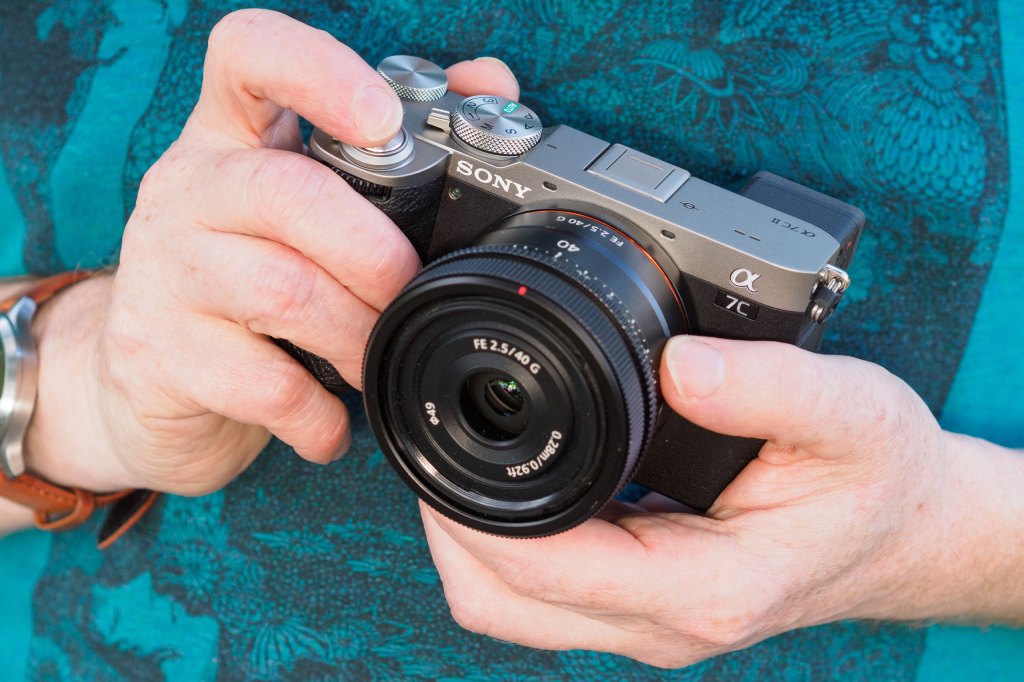
Amateur Photographer verdict
Smaller than its SLR-shaped peers, the Sony A7C II can deliver fine images, thanks to its superb sensor and autofocus system.- Big improvement on original A7C
- Subject-detection autofocus
- Stabilisation works very well
- Reduced-resolution RAW options are genuinely useful
- Small grip and no AF point controller / joystick
- Small, low-res viewfinder and screen
Specifications at a glance:
| Camera type | Mirrorless |
| Sensor | 33MP full-frame Exmor R CMOS |
| Continuous shooting | 10 frames per second |
| ISO | ISO 50-204,800 (extended) |
| Video | 4K 30p video recording (4K 60p with ‘Super 35’ 1.5x crop) |
The original Sony A7C was the smallest, cheapest full-frame mirrorless camera in Sony’s stable. Despite being an impressive technical achievement, our review left us a little disappointed: the size of the camera made it unnecessarily frustrating to operate. Nevertheless, Sony has committed to this format, and in 2023 we saw the arrival of the Sony A7C II.
Essentially, a Sony A7 IV crammed into a similarly tiny body to its predecessor, the Sony A7C II performs extremely well. It produces fantastic image quality, with impressive noise control at high ISOs. It inherits the subject-detect autofocus that has made its way into recent Sony cameras, and it can shoot at up to 10fps (though you need to use the lossy compressed raw in Hi+ mode to get this rate).
Awkward handling
While definitely an improvement over what came before it, the A7C II still exhibits several of the problems of the original A7C. Handling is undeniably awkward, with a small handgrip, paucity of control buttons and lack of an AF joystick. The screen and viewfinder are also both quite small and low-res for a camera at this price. Once again, there’s also the conceptual question surrounding a full-frame mirrorless camera of this size, given that it needs to be used with full-frame lenses, many of which will negate the weight-saving.
Best for: Travel photography and video
Read our Sony A7C II review.
Best APS-C
Best APS-C Sony all round: Sony A6700
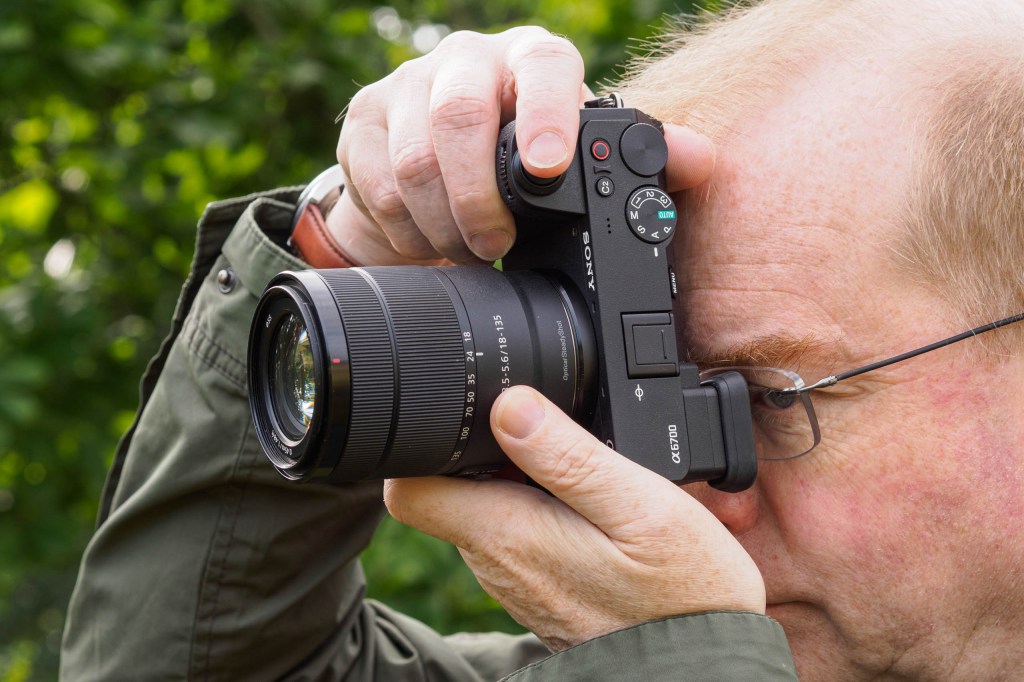
Amateur Photographer verdict
The Sony A6700 is the company’s best APS-C camera with a high resolution sensor, AI AF and excellent video, but the shooting experience leaves much to be desired.- Much improved design and control layout compared to A6600
- Compact body size relative to its peers
- Vari-angle rear screen
- In-body stabilization
- Powerful video features
- Controls can be frustrating
- 11fps burst shooting adequate but no more
- Only a single card slot
Specifications at a glance:
| Camera type | Mirrorless |
| Sensor | 26MP BSI-CMOS sensor |
| Continuous shooting | Up to 11 frames per second |
| ISO | ISO 100-32,000 standard, 50-102,400 (extended) |
| Video | 4K video recording up to 120fps |
The Sony A6700 is the latest model in Sony’s line-up and replaces the previous flagship A6600 model. It has a new 26MP sensor first seen in the company’s FX30 cinema camera, but in body designed for hybrid shooting – i.e. both stills and video photography. The body is slightly thicker than the previous Sony A6600 but still very compact, thanks to its ‘rangefinder’ design which incorporates an electronic viewfinder set into the back corner rather than mounted on the top of the body.
AI processor
This is a camera designed for video as well as stills, and it offers a big step up in technical specifications, notably the ability to capture full-width (no crop) 4K video and 30p and 60p oversampled from the camera’s full 7K resolution, and even 4K 120p video, albeit with a crop. This camera incorporates Sony’s latest AI-driven subject-detect autofocus and the dedicated AI processor first seen in the mighty Sony A7R V.
The A6700 is a very mighty camera indeed, and the only thing stopping it from hitting top spot in our list is its handling and controls, which are improved over previous versions but still sometimes frustrating.
Best for: vloggers, hybrid content creators and filmmakers
Read our Sony A6700 review.
Best lightweight high-res
Best lightweight high-resolution Sony camera: Sony A7CR
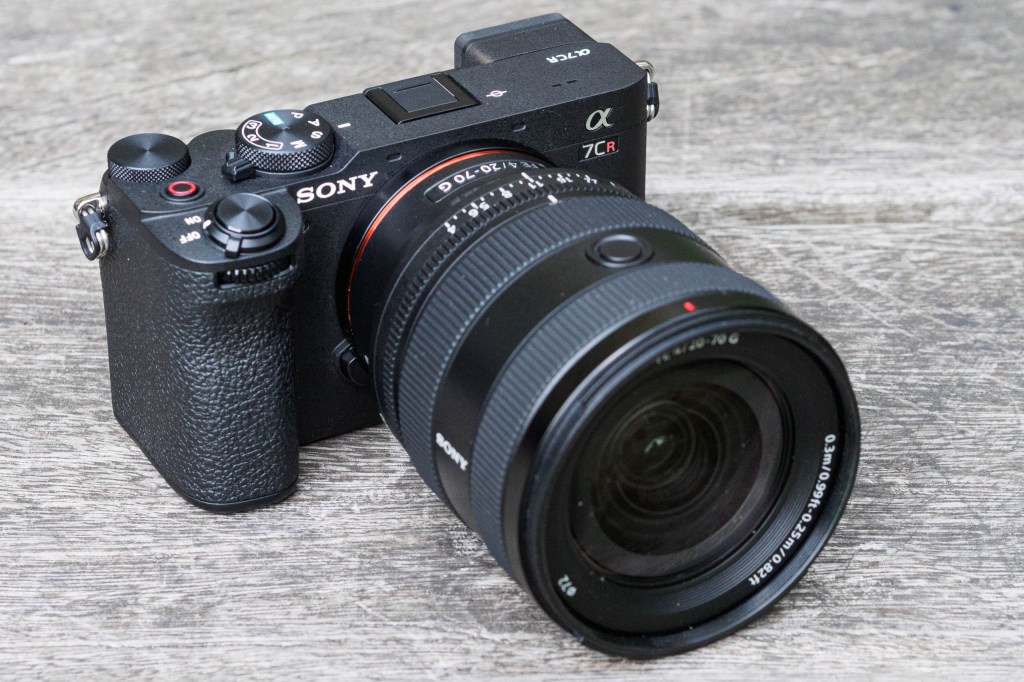
Amateur Photographer verdict
You get the same exceptional image quality and superb autofocus system as the A7R V, but in a smaller, lighter, and less expensive body.- Exceptional image quality
- Subject-detection autofocus
- Useful reduced resolution options
- Compromised controls and small handgrip
- One SD card slot (on a camera that creates big files)
- Small, low-res viewfinder and screen
Specifications at a glance:
| Camera type | Mirrorless |
| Sensor | 60MP full-frame CMOS sensor |
| Continuous shooting | 8 frames per second |
| ISO | ISO 50-102,400 (extended) |
| Video | 4K 60p video recording |
If browsing this guide, you like the sound of the A7R V’s resolution but wish it could come in a camera body the size of the A6700 – then your weirdly specific dreams have been realised. The Sony A7CR is of a piece with the Sony A7C II, in that it’s another camera that crams a lot of tech into a very small body.
Here, we get a 61MP full-frame sensor and Bionz XR processor, an on-sensor phase-detection autofocus system boasting 693 autofocus points. The AI-powered subject-detection system is present and correct, though the simplified shutter mechanism means a top speed of 1/4000sec rather than 1/8000sec. It also lacks a mechanical front curtain, and while this generally isn’t much of a problem, the electronic front curtain can sometimes cause unattractive background blur when you’re shooting at large apertures (a problem that can be fixed by switching to the electronic shutter, though you then run the risk of rolling shutter effects).
Small is king?
Once again, if you’re as obsessed with smaller-than-ever cameras as Sony is then you probably love the sound of the Sony A7CR – and if not, you’re probably wondering what you’re missing here. It’s true that this camera offers the same image quality as the A7R V in a smaller package, but you also have to put up with a lack of an AF joystick, a single card slot and a rather poky viewfinder. We have to wonder whether these cameras really provide such an advantage with a big full-frame lens attached.
As we said in our review, ‘The A7CR offers stunning image quality in a compact package, just as long as you’re prepared to accept the compromises this entails.‘
Best for: pro shooters who need to travel light
Read our Sony A7CR review.
Best for pros
Best Sony camera for professionals: Sony A1 II
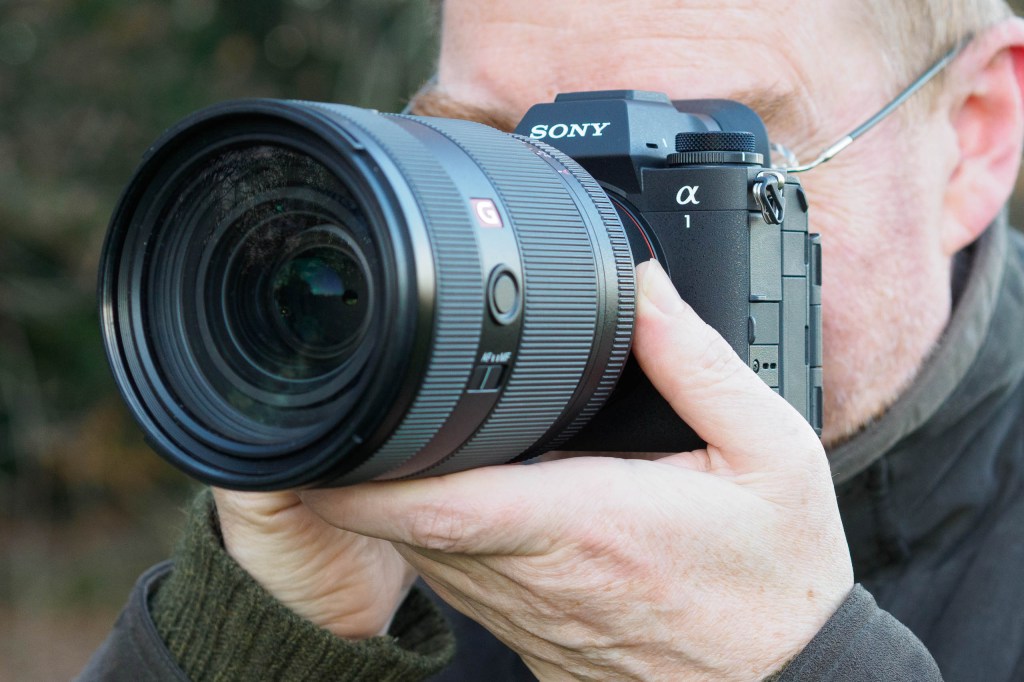
Amateur Photographer verdict
The new flagship mirrorless full-frame offering is the best camera Sony has ever made – but it costs much more than mirrorless rivals without really offering anything to set itself apart.- Superb viewfinder and screen
- Impressive image quality
- Excellent AF with auto subject detection
- Fast shooting speeds
- Absurdly expensive, more so than rivals
- Doesn’t offer anything unique
Specifications at a glance:
| Camera type | Mirrorless |
| Sensor | 50MP full-frame stacked-CMOS |
| Continuous shooting | 30 frames per second |
| ISO | ISO 50-102,400 (extended) |
| Video | 8K 30p |
The original Sony A1 was one of the first monster ‘do-everything’ professional mirrorless cameras. No longer would pros have to choose between speed and resolution – here was the camera that could handle both. The Sony A1 II consolidates and builds on that legacy. It’s the most advanced camera Sony has ever made, and unquestionably the choice for Sony-using pros – but it comes at a sky-high price, and that complicates the picture somewhat.
The Sony A1 II is very similar to the A1, offering a 50MP stacked sensor design, with 30fps burst shooting, a maximum shutter speed of 1/32,000sec, 1/400sec flash sync and 8K 30p video. The improvements are mostly in the autofocus, with Sony having incorporated a new AI processor that brings its subject-detection autofocus modes bang up to date. The clever system – able to recognise humans, animals, vehicles and many other specific subjects – is much faster than it was before, and has an auto detection mode rather than needing the subject to be pre-selected. Also, with 759 selectable focus points and 92% frame coverage, you’ll be fine getting the shot even without the AI system. Pros will also want to note that the A1 II has a built-in ethernet port for fast image downloads.
A competitive field
So, yes, the Sony A1 II is one of the most advanced cameras around, and certainly the best Sony camera. However, it comes at an absolutely sky-high price, costing significantly more than comparable mirrorless rivals like the Nikon Z8 and the Canon EOS R5 Mark II, and it doesn’t really do a lot of things better than those cameras. Certainly not enough to justify such a hike.
We gave the Sony A1 II a full five stars in our review, because it is a five-star camera. However, the full picture is a little complicated because it’s only really worth the buy if you’re a pro who’s heavily invested in the Sony E-mount system. If not, then it’s hard to escape from the fact that this camera is almost double the price of the Nikon Z8, and does not offer double the capability.
Best for: big-budget pros
Read our Sony A1 II review.
Best for sports
Best Sony camera for sports photography: Sony A9 III
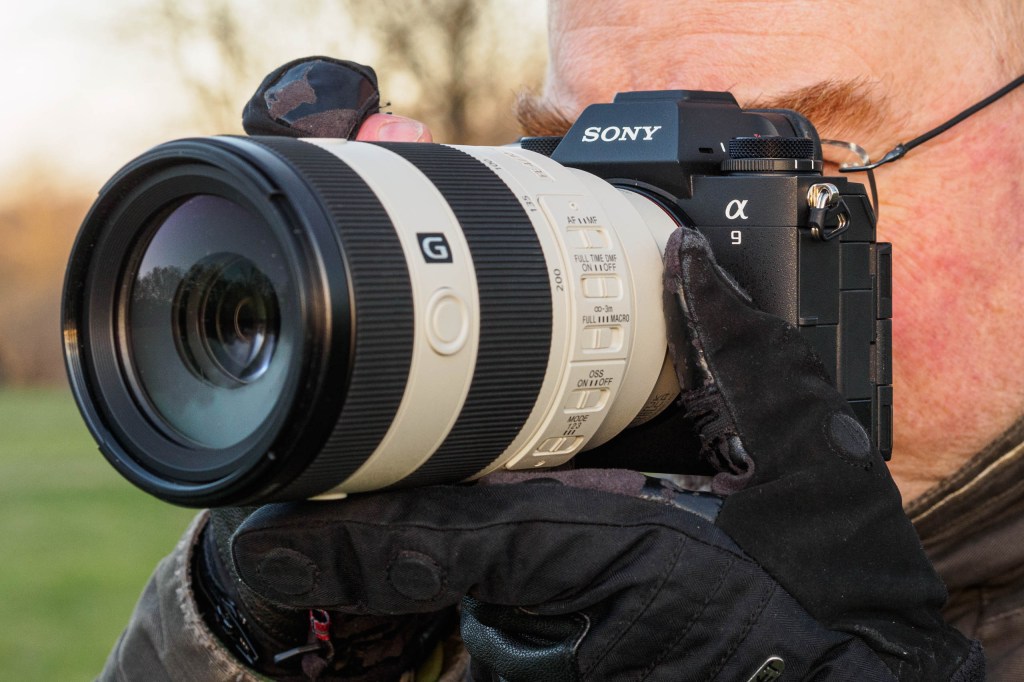
Amateur Photographer verdict
With its groundbreaking global shutter sensor, the Sony A9 III is a new milestone for sports photography. It’s utterly superb for this purpose — though too specialised and expensive for anything else.- Extraordinary autofocus and continuous shooting
- Flash sync available at any shutter speed
- No banding under artificial lighting
- No rolling shutter distortion
- Minimum ISO 250 native sensitivity limits image quality
- Relatively poor dynamic range and high-ISO performance
Specifications at a glance:
| Camera type | Mirrorless |
| Sensor | 24.6MP full-frame stacked-CMOS sensor with global shutter |
| Continuous shooting | 120 frames per second |
| ISO | ISO 250-125-51,200 (extended) |
| Video | 4K 120p |
Sony shook up sports and action photography with its blisteringly fast A9, and later consolidated its victory with the improved A9 II. From there, the line went a bit quiet, and the release of the fast-shooting Sony A1 led some to question whether the A9 line was being gently retired. Nope! The Sony A9 III made its spectacular debut at the tail end of 2023 — the first full-frame camera with a global shutter sensor, allowing it to expose and read out every single pixel simultaneously, rather than line by line as in other sports cameras.
What this means in real terms is no rolling shutter distortion due to rolling shutter, no banding artefacts in artificial light, and flash sync available at all shutter speeds without needing to use a power-sapping high-speed sync mode. Pair all this with an incredible, capable continuous shooting and autofocus system that allows for shooting at up to 120fps with full AF tracking and no viewfinder blackout, and you start to see what an incredibly capable sports camera this is.
A true specialist
Of course, that’s just what it is — an incredible sports camera. It’s specialised to the point where its native base ISO is 250 and its resolution is a comparatively low 24.6MP. These numbers make perfect sense for sports shooters, who generally use higher ISOs to compensate for fast shutter speeds, and don’t need extra resolution that is mostly just going to slow down the process of sending files to sports desks. For anyone else though, this is something of a detriment, especially in a camera with a price tag of $6000 / £6100 body-only. For this reason, the Sony A9 III is a near-perfect camera for professional sports shooters, but not particularly suitable for anybody else.
Best for: sports pros
Read our Sony A9 III review.
Best for video
Best Sony camera for video: Sony A7S III
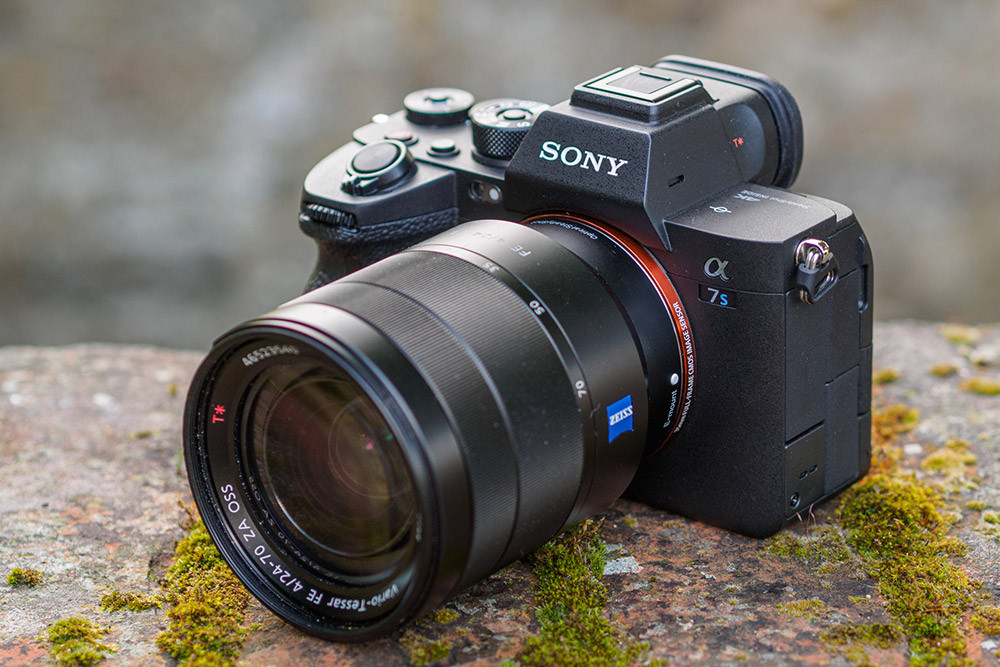
Amateur Photographer verdict
One of Sony’s best-ever cameras, this low-light wonder is also one of the best 4K cameras you can buy – though the 12MP sensor won’t be enough for photographers.- Superb video options
- Exceptionally beautiful viewfinder
- Unreal low-light capabilities
- Getting the best out of it requires pricey CFexpress cards
- Low sensor resolution
Specifications at a glance:
| Camera type | Mirrorless |
| Sensor | 12.1MP full-frame back-illuminated CMOS sensor |
| Continuous shooting | 10 frames per second |
| ISO | ISO 80-40-409,600 extended |
| Video | 4K 120p |
The full-frame Sony A7S cameras were originally introduced as low-light photography specialists. However, they were quickly adopted by the videography community, and Sony leant into this, producing successor models with better and better video specs.
The A7S III boasts all the refined handling the series is known for, but brings a newly designed back-illuminated Exmor-R sensor to the party. This means faster readout speeds, cleaner ISO performance, better phase-detection focusing and much more.
While it’s not an 8K camera, the A7S III captures 4K video at up to 120fps, with 10-bit 4:2:2 colour and All-I compression at 600Mbps. It looks superb, and thanks to the camera’s improved internal structure, it dissipates heat effectively for long recording times (Sony claims at least an hour of 4K 60p). There’s a huge suite of video options, including Log profiles, 24-bit internal audio recording – we could go on. Suffice to say, this is the full package when it comes to video.
Class-leading viewfinder
A somewhat surprising standout feature of this camera is an absolutely divine electronic viewfinder. With 9.44m dots of resolution, it’s an absolute monster for brightness and detail, and firmly puts to bed any lingering arguments about DSLR optical viewfinders being superior. This is just light-years ahead.
Sony also, thankfully, overhauled the menu system. This might sound like a trivial point, but Sony cameras have for years been held back by their ungainly, unintuitive menu systems, and the touch interface of the A7S III is a total breath of fresh air.
Best for: Video and vlogging
Read our full Sony A7S III review.
Best for travel
Best Sony for travel photography: Sony RX100 VII
Amateur Photographer verdict
Incredible tech in a tiny and pocketable body, a phenomenally capable camera for those who can afford it and live with its operating frustrations.- Lens sharp throughout zoom range
- Very good image quality
- Pop-up viewfinder
- Snappy autofocus
- Small body makes for tricky handling
- Poor battery life
Specifications at a glance:
| Camera type | Compact camera with 24-200mm equiv. f/2.8-4.5 lens |
| Sensor | 20.1MP 1-inch Exmor RS CMOS |
| Continuous shooting | 20 frames per second |
| ISO | ISO 125-12,800 |
| Video | 4K 25p |
Sony’s latest RX100 compact camera, the RX100 VII with a new 20.1-MP, 1-inch type Exmor RS CMOS sensor and Sony’s Bionz X processing engine, replacing the previous hybrid AF syste,m has a lot going for it but also suffers from some design flaws.
It’s got the same 24-200mm lens as the previous RX100 VI, and covers a great focal range. It also packs in plenty of high-end features for a camera in this class. The real-time Eye AF and Real-time Tracking systems are very effective at holding focus on subjects during stills and video shooting.
Slip it in your pocket
The little Sony RX100 VII is super compact and pocketable, meaning it’s ideal for city breaks and hikes as it won’t add much weight to your bag. The pop-up viewfinder is a nice touch as well, and 4K video at 25p with full pixel readout is super handy. The only downside is that its astonishing feature set is crammed inside a body and interface design that does little justice to it.
That said, in our review, we were consistently impressed by how much technology was packed into the RX100 VII’s tiny body, saying, ‘This is, without doubt, the most accomplished pocket camera on the market.
Best for: world-explorer photographers who travel light
Read our Sony RX100 VII review.
Best for travel vlogging
Best Sony camera for travel vlogging: Sony ZV-1 Mark II
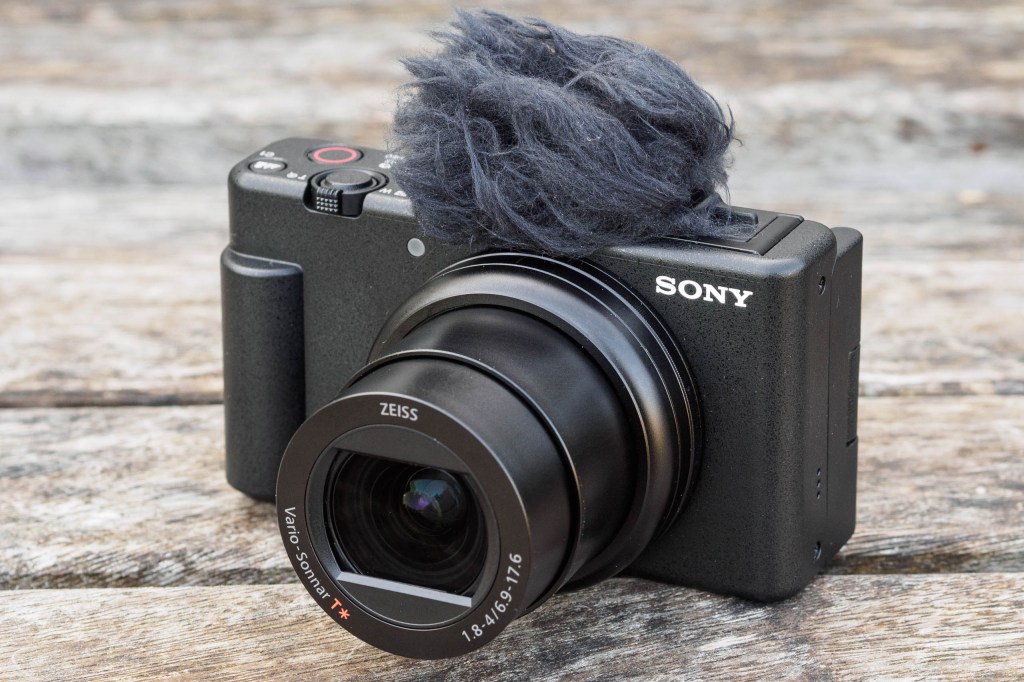
Amateur Photographer verdict
All in all one of the best cameras for vlogging and its compact size will appeal to those who don’t want to drag around a heavy camera.- Extra wide zoom lens
- Improved touchscreen interface
- Easy for vloggers to pick up and use
- No optical stabilisation
- Better background blur on original ZV-1
Specifications at a glance:
| Camera type | Compact camera |
| Sensor | 20MP 1-inch type CMOS |
| Continuous shooting | 24 frames per second |
| ISO | ISO 125-12,800 (ISO 80 extended) |
| Video | 4K 30p |
While it seems unlikely that Sony will produce any more stills-focused compact cameras in the near future, in the vlogging world these cameras are having something of a renaissance. Enter from stage left the Sony ZV-1 Mark II, the latest release from Sony and a successor to the popular, vlogger-oriented ZV-1.
This isn’t so much a replacement for that camera as it is an update. The ZV-1 II offers a similar feature set in a lot of ways, fielding a 20MP 1-inch type CMOS sensor, a flip-around touchscreen.
Zoom range
The key difference though is in the lens – the ZV-1 II’s lens is significantly wider than that of the ZV-1, covering an 18-50mm equivalent focal range compared to 25-70mm equivalent. This makes it wide enough for arm’s length vlogging – a criticism levelled at the ZV-1 – and is unique among zoom compact cameras generally, making the ZV-1 Mark II potentially an interesting camera for stills shooters too.
Naturally, it comes with drawbacks. While you do still get an f/1.8 maximum aperture, this drops to f/2.8 once you zoom past 24mm and f/4 at 35mm. This means you get less in the way of attractive background blur, even when you’ve activated Sony’s Background Defocus mode. This certainly isn’t a ruinous issue, but if you do want to capture images with a shallow depth of field and the background nicely thrown out, the original (and significantly cheaper) ZV-1 may be a better choice.
Ultimately though, this is still one of the best cameras for vloggers. In our review we appreciated how Sony has overhauled the touch interface to make the camera much easier to use, and the new directionality settings on the built-in mics. Vloggers are unlikely to be disappointed with this one.
Best for: vloggers and aspiring YouTubers
Read our Sony ZV-1 Mark II review.
Best ultra-zoom
Best Sony bridge camera: Sony Cyber-Shot RX10 IV
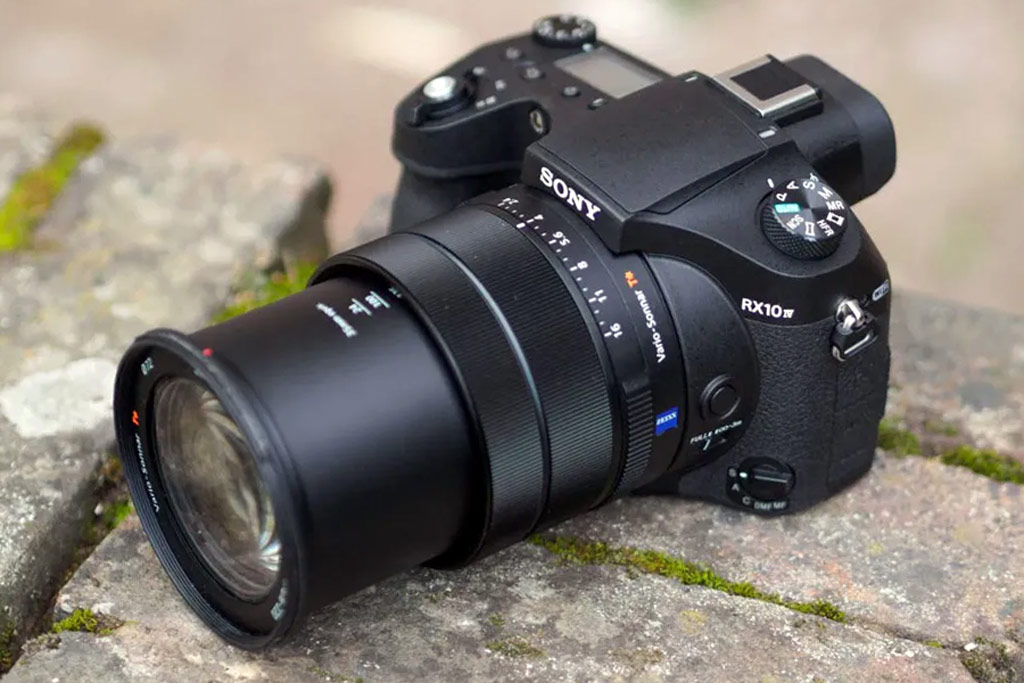
Amateur Photographer verdict
A premium all rounder bridge camera that will cover any shooting scenario, but it costs as much as an APS-C camera body.- Huge, high-quality zoom
- Fast burst shooting
- Price has come down
- Screen tilts but is not fully articulated
- No AF-area joystick or AF-on button
Specifications at a glance:
| Camera type | Bridge camera with 24-600mm (equivalent) f/2.4-4 lens |
| Sensor | 20.1MP 1-inch |
| Continuous shooting | 24 frames per second |
| ISO | ISO 64-12,800 (extended) |
| Video | 4K 25p |
The Sony RX10 IV is one of the most powerful bridge cameras ever made. A great, self-contained choice for wildlife photography, it pairs a 20.1MP 1-inch sensor with a 24-600mm (equivalent) f/2.4-4 lens, and also sports an incredibly capable autofocus system that consistently nails moving subjects.
The asking price has come down since launch, making the RX10 IV a much more tempting prospect than it was in the past. Those who want a marriage of image quality and convenience in a camera should really consider the RX10 IV; however, it has been increasingly difficult to find on the second-hand market.
Impressive up to 600mm
In our testing, we found that the sensor/lens combination delivers excellent image quality across the board. Many bridge cameras offer an enormous shooting range, but in practice their image quality is overly compromised at the extreme ends of their big lenses. No such issues here – you can push the Sony RX10 IV to 600mm and still get great images, though there is some fall-off if you stop down past f/8.
Our verdict? ‘The Sony Cyber-shot RX10 IV sets a new standard for all-in-one superzoom models. If you’re interested in getting an all-in-one travel camera, or simply want to photograph your local wildlife without needing to buy a huge zoom lens for a DSLR, it’s the best you can buy.‘
Best for: wildlife photographers who want an all-in-one package
Read our Sony RX10 IV review.
Best used Sony cameras
Here’s a selection of Sony cameras which are no longer sold new but can be strongly recommended as used buys. There are plenty of these on the used camera market, often in excellent or as-new condition and showing few signs of wear. If your main interest is video, you might be better off going for one of the new Sony cameras above, but if you are principally interested in stills photography, these models deliver much of the resolution and performance of current models, but at a fraction of the price.
Best used for beginners
Best used Sony camera for beginners: Sony A6000
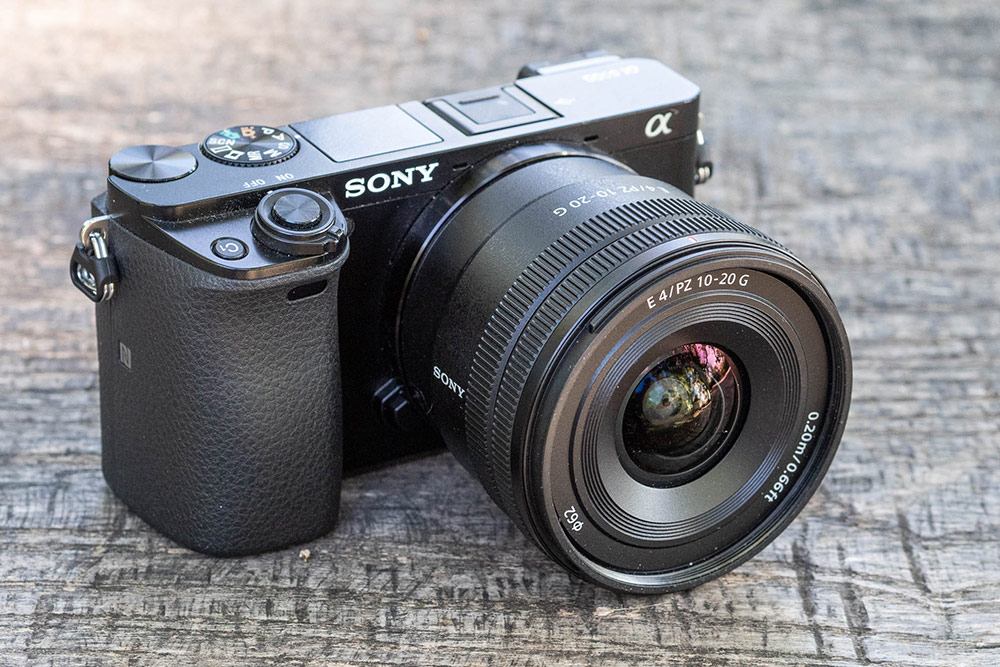
Amateur Photographer verdict
Offers a great entry into the mirrorless camera world, and even now, nearly 10 years after its launch a very capable camera.- Fantastic value for money
- Good burst speeds
- Sleek, attractive design
- Showing age in video
- No in-camera raw processing
Specifications at a glance:
| Camera type | Mirrorless |
| Sensor | 24.3MP APS-C CMOS |
| Continuous shooting | 11 frames per second |
| ISO | ISO 100-25,600 |
| Video | Full HD 60p |
This fantastic camera has been around since 2014, and the fact that it’s still one of the best mirrorless cameras for beginners is an indicator of how many things Sony got right with it. The Sony A6000 kicked off an entire series of APS-C mirrorless cameras for enthusiasts, and over the years its price has come down to the point where it’s one of the best budget cameras you can buy. There are also plenty of E-mount lenses designed specifically for APS-C cameras, so you won’t feel short-changed when it comes to the glass.
Competitive specs
It’s amazing how many of the A6000’s specs are still competitive today. The autofocus system can acquire a subject in as little as 0.06 seconds, and the burst mode can manage 11fps – all of which is more than enough for speedy action photography. The only area where the A6000 has started to fall behind is video, as it pre-dates the 4K boom, and doesn’t have a mic jack.
In our review when the A6000 came out, we said, ‘Top-spec technology and a host of cutting-edge features may just see the Alpha 6000 mirror the longevity and success of its predecessor and keep it competitive in years to come.‘ Not to toot our own horns, but we called that one pretty well.
Best for: cash-conscious beginners and enthusiasts
Read our Sony A6000 review.
Best used for resolution
Best used Sony camera for image quality: Sony A7R II
Amateur Photographer verdict
It remains popular and is a favourite of landscape photographers and anyone who’d like to resolve extremely fine detail.- Superb resolution for the money
- Does very well at high ISOs
- Relatively lightweight and portable
- Only one card slot
- Pedestrian 5fps burst rate
Specifications at a glance:
| Camera type | Mirrorless |
| Sensor | 42.4MP Exmor R BSI-CMOS |
| Continuous shooting | 5 frames per second |
| ISO | ISO 50-102,400 (extended) |
| Video | 4K 30p |
Released in 2015, the full-frame Sony A7R II has since been discontinued. However, it is still widely available on the second-hand market, and if you’re looking for high-resolution full-frame shooting, we reckon it’s one of the best bargains you’ll find.
It’s a camera that demands plenty of accuracy on the part of the user. 42 megapixels is an unforgiving resolution, and if you’re a hair off on your focusing, it’s going to be noticeable. Fortunately, the Sony A7R II was the first high-resolution mirrorless camera to come sporting 5-axis image stabilisation, meaning it’s easier to shoot at slow shutter speeds and still get pin-sharp shots.
Impressive detail at ISO 25,600
We published a special feature not long ago on why the Sony A7R II is one of the best used cameras you can buy, and one of the features we singled out was its high-ISO performance. You can push the A7R II all the way up to ISO 25,600, and it’ll still handle detail really well.
The A7R II proved something of a favourite among the professional photography community. Landscape pro Joe Cornish was blown away by the high-ISO performance of the A7R II, and appreciated its lightweight build for use out in the field. Meanwhile, we also saw motorsport photography pro Nick Dungan put the A7R II through its paces on the track. It’s not really designed for this genre, but the A7R II did well at nailing challenging shots, and Nick ended up concluding he would seriously consider adding it to his kit bag.
Best for: getting ultra-high resolution as cheaply as possible
How to choose the best Sony camera
Camera types
Sony manufactures cameras in two classes: compacts and mirrorless cameras. Compact cameras have a fixed lens that can’t be changed, while mirrorless cameras allow the user to swap between Sony E-mount lenses at will. Compact cameras are generally smaller, sometimes cheaper and easier to use, while mirrorless cameras offer greater image quality and shooting versatility, with the trade-off being that a complete mirrorless setup can cost quite a bit more, and be less portable.
Sensor size
Sony compact cameras have 1-inch sensors, and Sony mirrorless cameras will use either APS-C or full-frame. Which to choose? Full-frame sensors will deliver the best image quality and overall performance, particularly in low light, but require larger and more expensive cameras and lenses. APS-C tends to be thought of as the mid-range option, and this is the sensor size used in the Sony A6700.
For a thorough run-down, check out our guide to APS-C vs full-frame sensors.
Features and priorities
You need to figure out which features are most important to you. Want to capture wildlife images? Look for fast burst speeds and sophisticated autofocus systems. If you’re looking to add video to your repertoire as well as stills, you’ll want to look at the maximum video resolution and frame rate the camera can capture. Sony makes some of the best hybrid cameras for photographers who need both.
Still not sure on what type of camera you’re looking for? You may want to check out our guide to DSLR vs mirrorless. And if you do end up choosing a Sony mirrorless, you’ll want to pick up some of the best Sony lenses to go with it.
How to charge your Sony camera
Almost all Sony cameras use USB charging, so you can simply plug in the charger in the box, or the USB cable into a spare charger (or USB port), and charge your camera. If you want to charge the battery outside of the camera, then a spare battery charger can be bought from all the usual retailers.
How we test Sony cameras
We test Sony cameras primarily by using them to take photographs and video in a wide range of real-world situations. We evaluate their control layouts and handling, and the usability of their viewfinders and screens. We assess their autofocus across a range of different subjects and shooting scenarios and check their continuous shooting capabilities.
We also examine the effectiveness of their image stabilisation systems. Last but by no means least, we critically evaluate the image quality, in both JPEG and raw, including resolution, high-ISO noise, and dynamic range. We then take all these factors into account, along with such things as portability and lens systems, when giving our final conclusion and score. You’ll find the full breakdown of how each camera has performed in our full reviews.
Found your perfect Sony camera? Why not have a look at some of our choices for the best Sony lenses (E-mount), have a look at our other buying guides, and our latest reviews, for more great products.

